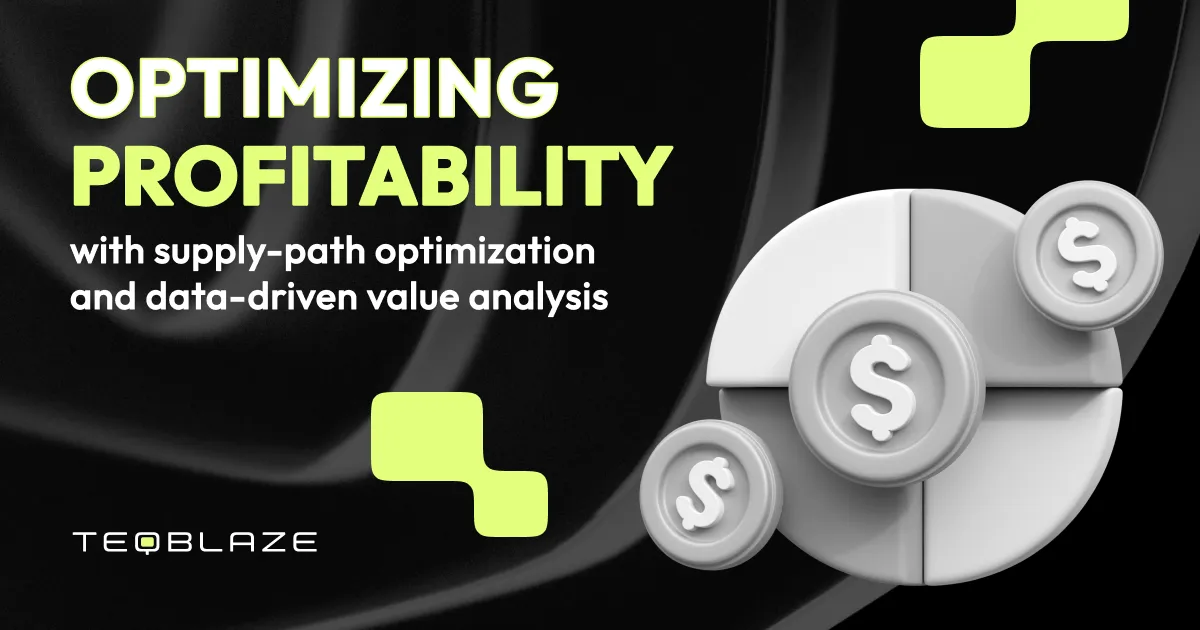Programmatic is similar to theater. The actors perform, the audience enjoys, the screenwriters and technicians do their best to maintain the magic in the shadows. But there is a person behind it who does the most important job — the theater director. He recruits people, pays salaries, negotiates with contractors, and makes strategic decisions. He understands theater art because he hires key figures. Furthermore, he also understands which contractor to order scenery from, which marketing agency to work with, and what conditions the theater can offer to actors.
When we talk about optimizing the supply chains for advertising inventory, we speak about the role of the theater director — the one who sees more than others and does the jewelry work of managing the entire organism.
Definition. Supply-path optimization analyzes advertising chains, ranks them by profitability, and then modifies them. This can include blocking certain chains, prioritizing others, turning off nodes, and applying various rules to improve profitability.
Goal. The SPO process aims to increase profitability, advance user experience by providing relevant, positive engagement ads, and maintain reputational security with high control over ad quality. As a pleasant bonus, it also reduces server workloads.
Profit. Publishers and the owners of the ad platforms benefit the most from the SPO. The process increases their profits and improves the quality of the ad content. Advertisers also benefit from the SPO, but only direct advertisers. All advertising sides are interested in this optimization.
Why is it essential to optimize supply chains?
Because the programmatic advertising ecosystem is overloaded with duplicate bids, traffic resale through tenth parties, and simply irrelevant requests in quantities that overload servers.
This can be compared to emails. At the very beginning, people received a couple of emails a week, and they were meaningful and rarely aroused suspicion. Today, we all receive hundreds of emails weekly, half of which are spam, scams, and other junk. Another quarter are automatic mailings to cold and hot clients. And the last quarter is something already valuable to work with. The same is true for programmatic advertising trading. The comparison ratio between emails and queries per second in programmatic advertising is one to thousands.
Who handles the SPO process?
The owners of the SSPs and other platforms that serve the needs of the suppliers do it for their publishers and themselves — probably foremost — for themselves. Or there is no priority. These are interconnected motivations.
The supply-path optimization process consists of two components.
The technical SPO toolkit for analyzing advertising chains and managing their settings.
The platform administrator for analyzing, assessing, and changing settings. Then, applying, testing, and studying. Next, the same steps again to fine-tune the ecosystem.
If the platform administrator does not own a platform developed by an in-house team, a personal Account Manager or Customer Support Manager provided on behalf of the technology vendor should assist them in the SPO process.
Why is SPO critical in 2024–2025?
Because it has been necessary for developing programmatic ecosystems since 2023, and the trend is only gaining momentum. For instance, automated processes are emerging to facilitate supply chain optimization. However, manual control and adjustments are priorities and will always be advantageous over purely automated optimization.
The 2.5 white-label SSP + Ad Exchange platform update released the SPO Toolkit. After testing on clients’ platforms and receiving detailed feedback, our engineers work on expanding the functionality of the SPO toolkit and deploying automated algorithms. A necessary clarification that is not obvious: the SPO toolkit operates within the white-label ad exchange functionality, which is part of the white-label supply-side platform.
While only some supply platforms on the market are also ad exchanges, only a few platforms support the SPO process from a technical perspective.
When does SPO optimization yield the greatest results?
When the platform owner has an expanded network of demand-side partners engaged through OpenRTB and header bidding, there is much material to work with, and the result of SPO will be clear and significant.
The opposite situation is a platform that works mainly with direct advertisers through APIs or PMP deals. In this case, optimization results will be limited.
The general rule of thumb is that the greater the number of intermediary partners you have and the higher the traffic resale through different ad exchanges, the more critical SPO optimization becomes. Nevertheless, basic improvements are guaranteed for any programmatic ecosystem.
Can the SPO have a negative effect?
Potentially, yes. It's like with medicines: if you misuse them, they can be harmful — apart from fake medicines. But supply-path optimization is a proven treatment.
Fortunately, supply chain optimization is a technical process. A responsible person can apply a rule and realize that the performance has declined after a particular trading period. Returning to the previous settings or using new ones takes 2–3 clicks on the platform. It is a tuning process, just like with stringed instruments: overturning or undertuning is unsuitable; you need a clean note.
Let's look at a fundamental and fairly basic example. You open the SPO toolkit, and with a single switch, you turn off all indirect traffic to the platform. Performance drops dramatically because this is a very rough rule. Still, sometimes, it is necessary to understand how indirect traffic affects trading. Having 2 or 3 hops in the supply chain might be more profitable than just one direct connection. SPO toolkit gives you all the insights about it. As soon as you turn off the switch, the platform starts trading again as before. All information about the performance changes is available in the detailed performance analysis tool within the SPO toolkit.
By making small and exceptionally positive changes to the supply chains, you can gradually and smoothly improve trading while testing theories with little risk of decreasing performance.
The role of data analysis in fine-tuning supply chains
Data is the backbone of any successful supply-path optimization strategy. Without a clear understanding of how each node in the supply chain performs, the optimization process becomes a guessing game.
The supply-path optimization allows you to fine-tune the entire chain by analyzing particular data points. With the right data analytics, platform administrators can pinpoint which paths drive profits and which are eating into margins. The deeper the analysis, the more informed decisions can be made.
For instance, if a specific DSP consistently offers low-quality bids or inflated prices, the SPO toolkit will help you either deprioritize or block that path entirely, rerouting demand through more profitable channels.
Fine-tuning isn't a one-time exercise. It's a process of continuous data-driven adjustments. Administrators can measure its impact for rapid iteration and improvement each time a rule is applied. Using a data-driven approach, you eliminate inefficiencies and identify high-value partners that should be prioritized in future campaigns.
Principal metrics to watch for while carrying SPO for your business
Nobody will tell you the truth in full. It is a story without a happy ending because war is always fought where market competition rages.
Different companies offer diverse metrics to consider while optimizing supply chains for your business. There are basic ones and advanced ones. Advanced metrics to consider are the commercial secret. So be ready to read half-truths in all the marketing materials on the internet.
Fill rate. One of the core indicators of how effectively a supply path is monetizing. A low fill rate suggests that specific demand paths are not meeting the required bid thresholds or are too niche to be competitive.
Effective cost per mille. eCPM is a direct reflection of how well a supply chain is monetized. By analyzing eCPM across different supply paths, administrators can quickly identify which sources yield the highest returns and which are underperforming.
Ad load time. In the programmatic world, speed is everything. Latency, or the time it takes for an ad to load, can dramatically impact the user experience and conversion rates. Reducing latency through SPO improves performance and enhances the end-user experience by ensuring ads are displayed without delay.
Bid win rate. Understanding how often bids win in different supply paths helps refine bid strategies. Suppose a particular supply path has a low win rate. In that case, it may be oversaturated or overpriced, leading to wasted impressions and underperformance.
Click-through rate. A higher CTR indicates more relevant and engaging ads. SPO can help improve CTR by ensuring ads are delivered through paths that align better with user intent and content context.
Conversion rate. This metric shows how many users complete a desired action after seeing an ad, such as purchasing or signing up. High conversion rates suggest that specific supply paths better reach the right audiences, making them more valuable.
Demand path diversity. This metric tracks the number of different demand sources participating in your ad auctions. Diverse paths offer better chances to maximize revenue and reduce dependence on a single partner. Maintaining diversity helps protect against any performance drop in one supply source.
Revenue by supply path. By analyzing revenue generated by individual supply paths, administrators can identify which paths deliver the best financial returns. This metric indicates where optimization efforts should be targeted.
Focusing on the right KPIs ensures that optimizations have the desired effect. By tracking these KPIs, platform administrators can make targeted improvements that lead to higher profitability. The goal is to strike the perfect balance between user experience and ad performance. Eliminate inefficient paths and amplify the profitable ones, ensuring ads remain relevant and engaging to users.
Seeing value behind the lines of metrics is just a skill. Time and perseverance in SPO will quickly begin to reward you with growth in business performance. The best advice is simple: take your time and ensure you have experienced business developers' support. The TeqBlaze team is waiting for you to discuss the details. Let's be frank: we strive for mutual prosperity, which will take some work. Still, it should be an exciting journey. Do you feel it? The stage is set!

 Grigoriy Misilyuk
Grigoriy Misilyuk






